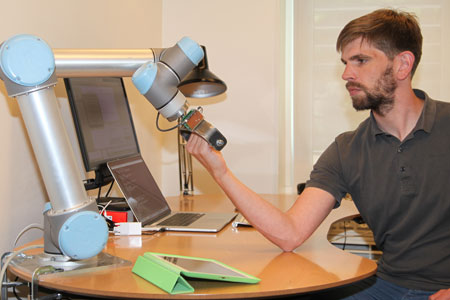
Industrial Robots to Rehabilitate Patients
Industrial robots will be developed to rehabilitate weak patients. The robot functions as a personal trainer. It can be set to accommodate the individual’s exact requirements and ensure that the patient develops to the maximum.
Robots must not only work in factories, they can be just as useful as personal trainers in the rehabilitation centre. They have great potential to rehabilitate patients who have lost their mobility after a blood clot or a brain haemorrhage.
- An ordinary exercise machine requires the patient to have the strength to at least lift the weight of his/her arms but a robot can be set to aid in the lifting process. It offers unprecedented opportunities for the most vulnerable patients, says Associate Professor Anders Stengaard Sørensen from the Maersk Mc-Kinney Moller Institute.
This is why researchers from the University of Southern Denmark have started programming an industrial robot-arm to become training partner for patients who do not have the strength to lift their arm themselves. The robot is programmed to sense how much help the patient requires to train his/her arm.
Great need for training robots
It is the first time researchers use industrial robots for rehabilitation, and there is a great need to develop training robots because the most vulnerable patients do not have a lot of rehabilitation opportunities today. This is why Anders Stengaard Sørensen has no doubt that robots will become the preferred means for rehabilitation in the future.
- As a rule, the weakest rehabilitation patients are offered rehabilitation in water, but this is very expensive because each patient has to be supervised by a therapist. Additionally, exoskeletons are starting to be seen on the market. Exoskeletons are a type of robot suit which is also quite expensive, says Anders Stengaard Sørensen and continues:
- Our basic idea is that we can make robotic rehabilitation cheaper and thus more accessible through the use of robots which are already used in the industry, he explains.
Ensures the patient’s optimal potential
However, it is not the first time Anders Stengaard Sørensen combines robots and rehabilitation. RoboTrainer was the first rehabilitation robot to resemble a regular exercise machine for biceps and triceps muscles in the upper arm. The robot was developed together with former elite soldier and training expert Allan Lauritsen.
- What is unique is that you can place an individual programme in the robot which ensures that the patient is adhering to his/her super-compensation-curve. This means that the robot provides training loads, so the patient’s muscles develop optimally, says Allan Lauritsen and elaborates:
- The robots can therefore be programmed so as to ensure that the patient achieves the optimal development and the robot can follow the progress and make sure the patient is constantly challenged. It corresponds having a personal trainer at one’s side constantly.
For more information contact
Anders Stengaard Sørensen at anss@mmmi.sdu.dk / mobil 2478 2365